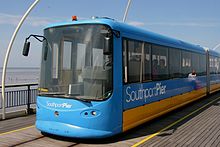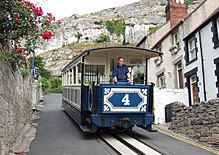From Wikipedia, the free encyclopedia
The
Little Eaton Gangway in 1908 with the last train of loaded coal wagons.
Model of a
Darlington Corporation Light Railways tramcar at the
National Tramway Museum .
The
Southport Pier Tramway .
The
Great Orme Tramway , a street-running
funicular .
Horse-drawn
slate wagon used on the
Nantlle Railway , now preserved at the
Welsh Slate Museum .
One of the first railways using 3 ft 6 in (1,067 mm ) gauge track was the
Little Eaton Gangway in England, constructed as a horse-drawn
wagonway in 1795. Other 3 ft 6 in (1,067 mm ) gauge wagonways in
England and
Wales were also built in the early 19th century. Also during this time, numerous tram networks were built in 3 ft 6 in (1,067 mm ) gauge (see table below).
Railways See also References
Minimum-gauge Minimum-gauge railways
Narrow gauge
2 foot and 600 mm
750 mm 2 ft 5+ 1 ⁄2 in )
760 mm 2 ft 5+ 15 ⁄16 in )
2 ft 6 in 762 mm )
800 mm 2 ft 7+ 1 ⁄2 in )
891 mm (2 ft 11+ 3 ⁄32 in )
Swedish three foot
900 mm 2 ft 11+ 7 ⁄16 in )
3 ft 914 mm )
950 mm 3 ft 1+ 3 ⁄8 in )
Italian metre gauge
1,000 mm (3 ft 3+ 3 ⁄8 in )
metre gauge
1,050 mm 3 ft 5+ 11 ⁄32 in ),
1,055 mm 3 ft 5+ 1 ⁄2 in ),
3 ft 6 in 1,067 mm )
1,093 mm 3 ft 7 in ),
1,100 mm 3 ft 7+ 5 ⁄16 in ),
1,200 mm 3 ft 11+ 1 ⁄4 in )
4 ft 1,219 mm )
4 ft 1 in (1,245 mm ),
Middleton Railway
4 ft 6 in 1,372 mm ), Scotch gauge
4 ft 6+ 1 ⁄2 in 1,384 mm ), Scotch gauge
4 ft 7+ 3 ⁄4 in 1,416 mm )
4 ft 8 in 1,422 mm ), almost standard gauge
4 ft 8+ 1 ⁄4 in 1,429 mm )
1,432 mm 4 ft 8+ 3 ⁄8 in )
Standard gauge
Broad gauge
1,440 mm 4 ft 8+ 11 ⁄16 in )
1,445 mm (4 ft 8+ 7 ⁄8 in )
1,450 mm 4 ft 9+ 3 ⁄32 in )
4 ft 9+ 3 ⁄8 in 1,457 mm )
1,458 mm 4 ft 9+ 13 ⁄32 in )
4 ft 10+ 7 ⁄8 in 1,495 mm ), Toronto gauge
5 ft / 1,524 mm and 1,520 mm 4 ft 11+ 27 ⁄32 in ), Russian gauge.
5 ft 2+ 1 ⁄4 in 1,581 mm and
5 ft 2+ 1 ⁄2 in 1,588 mm , Pennsylvania gauge
5 ft 3 in 1,600 mm ), Irish gauge
5 ft 4+ 1 ⁄2 in 1,638 mm ), Baltimore gauge
1,668 mm 5 ft 5+ 21 ⁄32 in ), Iberian gauge
5 ft 6 in 1,676 mm ), Indian gauge
7 ft 1 ⁄4 2,140 mm ), Brunel gauge
3,000 mm 9 ft 10+ 1 ⁄8 in ), Breitspurbahn
8,200 mm (26 ft 10+ 27 ⁄32 in ),
Lärchwandschrägaufzug 9,000 mm (29 ft 6+ 5 ⁄16 in ),
Krasnoyarsk ship lift List of track gauge articles Gauge differences Transport mode Categories






